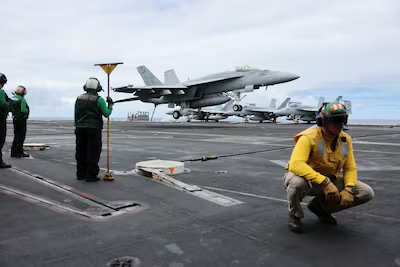Live updates: Follow the latest on Israel-Gaza
The US Navy has scaled back its nuclear-powered “super carrier” presence in the Middle East, with the USS Roosevelt returning home, leaving the USS Abraham Lincoln in the Gulf of Oman.
The cutback comes after defence analysts raised concerns that the US Navy was struggling to sustain a “naval surge” in both the Pacific – where an effort is under way to confront China – and the Middle East. A regional crisis involving multiple flash points in Gaza, the Red Sea, Israel and Lebanon, and Iran has left US carrier force stretched, they argue.
The US reinforced in the region in August, deploying the Lincoln in an effort to deter Iran from a widely anticipated direct attack on Israel, following the assassination of Hamas political leader Ismail Haniyeh in Tehran.
An Iranian attack on Israel in April – in retaliation for the bombing of the Iranian embassy in Damascus – had involved hundreds of ballistic and cruise missiles and drones. US, British and French air and naval forces, in conjunction with Israeli jets and missile defences, shot down more than 90 per cent of those missiles and drones. But experts say it is the carrier groups – aircraft platforms and supporting naval destroyers, each capable of launching up to 200 air strikes per day and firing hundreds of cruise missiles – that are optimum for deterrence.

When the Lincoln was deployed, the US claimed the presence of two carriers could give Iran pause for thought when considering how to retaliate for the July 31 assassination of Mr Haniyeh, which was widely blamed on Israel.
“We've moved capabilities into the region that I think it's fair to say have gotten into the headspace of Iran and will influence their calculation on how and if they choose to respond,” Pentagon deputy press secretary Sabrina Singh said last month.
Some analysts pointed out that while the US had deployed two carrier groups on this deterrence mission, there were none in the Red Sea. There US naval forces have been battling the Iran-backed Houthi militia, which is trying to shut down the crucial waterway. About 30 per cent of global container trade passes through the Red Sea, and traffic has fallen by around 60 per cent since the Houthis began attacking ships last November.
A US Navy admiral had said in October, at the start of the Israel-Gaza war, that American ships would “support the safe navigation and free flow of commerce”. Last month, Pentagon press secretary Gen Patrick Ryder denied there was a “carrier gap”, insisting the US has “the ability to surge forces and capabilities to where we need them, when we need them”.
The US Navy has traditionally tried to keep one of its aircraft carriers – which weigh around 100,000 tonnes and can carry between 70 and 90 attack and reconnaissance aircraft – in the Middle East. In times of crisis, such as the first Gulf War against Iraq in 1990 and 1991, that number has surged to as many as seven, although some of those ships were not nuclear-powered.
Washington has maintained a set number of carriers over the years in compliance with a law stating that the Navy will have “not less than 11 operational aircraft carriers”.
About four are kept at sea at a given time, due to the massive maintenance requirements. All but one currently serving are ageing Nimitz class carriers, slowly being replaced by modern Ford Class ships. One of these is operational, with the rest being delivered through to the mid-2030s.

